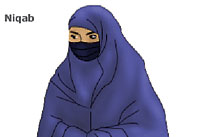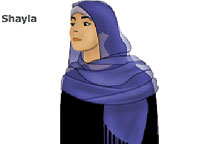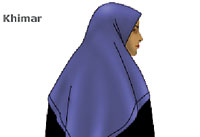Sunday Times 2
Hijab for a day: Non-Muslim women who try the headscarf
View(s):By Catrin Nye
World Hijab Day calls on non-Muslim women to try out life under the traditional head scarf. Can it lead to more religious tolerance and understanding?
“Because I’m not very skilled I’m wearing what you could call a one-piece hijab – you just pull it over your head. But I’ve discovered the scope is endless. There are all sorts of options.”

The word hijab comes from the Arabic for veil and are worn by Muslim women all around the world.
So says Jess Rhodes, 21, a student from Norwich in the UK. She had always wanted to try a headscarf but, as a non-Muslim, didn’t think it an option. So, when given the opportunity by a friend to try wearing the scarf, she took it.
“She assured me that I didn’t need to be Muslim, that it was just about modesty, although obviously linked to Islam, so I thought, ‘why not?’”
Rhodes is one of hundreds of non-Muslims who will be wearing the headscarf as part of the first annual World Hijab Day on 1 February.
Originated by New York woman Nazma Khan, the movement has been organised almost solely over social networking sites. It has attracted interest from Muslims and non-Muslims in more than 50 countries across the world. For many people, the hijab is a symbol of oppression and divisiveness. It’s a visible target that often bears the brunt of a larger debate about Islam in the West.
World Hijab Day is designed to counteract these controversies. It encourages non-Muslim women (or even Muslim women who do not ordinarily wear one) to don the hijab and experience what it’s like to do so, as part of a bid to foster better understanding.
“Growing up in the Bronx, in NYC, I experienced a great deal of discrimination due to my hijab,” says organiser Khan, who moved to New York from Bangladesh aged 11. She was the only “hijabi” (a word for someone who wears the headscarf) in her school.
“In middle school I was ‘Batman’ or ‘ninja,’” she says. “When I moved on to college it was just after 9/11, so they would call me Osama Bin Laden or terrorist. It was awful. “I figured the only way to end discrimination is if we ask our fellow sisters to experience hijab themselves.”
Khan had no idea the concept would result in support from all over the world. She says she has been contacted by people in dozens of countries, including the UK, Australia, India, Pakistan, France and Germany. The group’s literature has been translated into 22 languages.
It was social networking that got Jess Rhodes involved. Her friend Widyan Al Ubudy lives in Australia and asked her Facebook friends to participate. “My parents, their natural reaction was to wonder if this was a good idea,” says Rhodes, who decided to wear her hijab for a month.
“They were worried I would be attacked in the street because of a lack of tolerance.” Rhodes herself was concerned about the reaction, but after eight days of wearing the headscarf she has actually been surprised by how positive it has been.
(Courtesy BBC)
World Hijab day: The different Muslim headscarves
 The niqab is a veil for the face that leaves the area around the eyes clear. However, it may be worn with a separate eye veil. It is worn with an accompanying headscarf. |
 The shayla is a long, rectangular scarf popular in the Gulf region. It is wrapped around the head and tucked or pinned in place at the shoulders. |
 The khimar is a long, cape-like veil that hangs down to just above the waist. It covers the hair, neck and shoulders completely, but leaves the face clear. |
 The burka is the most concealing of all Islamic veils. It covers the entire face and body, leaving just a mesh screen to see through. |
Follow @timesonlinelk
comments powered by Disqus
















